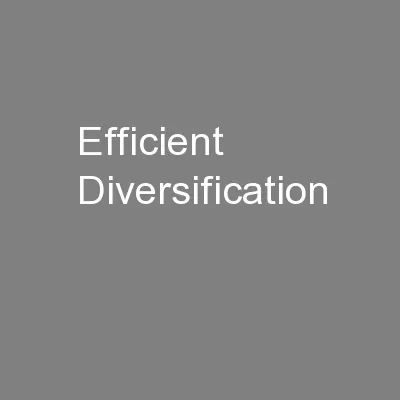

Bodie Kane and Marcus Essentials of Investments 9 th Global Edition 6 61 Diversification and Portfolio Risk MarketSystematicNon diversifiable Risk Risk factors common to whole economy ID: 391683
Download Presentation The PPT/PDF document "Efficient Diversification" is the property of its rightful owner. Permission is granted to download and print the materials on this web site for personal, non-commercial use only, and to display it on your personal computer provided you do not modify the materials and that you retain all copyright notices contained in the materials. By downloading content from our website, you accept the terms of this agreement.
Slide1
Efficient Diversification
Bodie, Kane and MarcusEssentials of Investments 9th Global Edition
6Slide2
6.1 Diversification and Portfolio Risk
Market/Systematic/Non diversifiable RiskRisk factors common to whole economyUnique/Firm-Specific/Nonsystematic/ Diversifiable RiskRisk that can be eliminated by diversificationSlide3
Figure 6.1 Risk as Function of Number of Stocks in PortfolioSlide4
Figure 6.2 Risk versus DiversificationSlide5
6.2 Asset Allocation with Two Risky Assets
Covariance and CorrelationPortfolio risk depends on covariance between returns of assetsExpected return on two-security portfolio Slide6
6.2 Asset Allocation with Two Risky Assets
Covariance CalculationsCorrelation CoefficientSlide7
Spreadsheet 6.1 Capital Market ExpectationsSlide8
Spreadsheet 6.2 Variance of ReturnsSlide9
Spreadsheet 6.3 Portfolio PerformanceSlide10
Spreadsheet 6.4 Return CovarianceSlide11
6.2 Asset Allocation with Two Risky Assets
Using Historical DataVariability/covariability change slowly over timeUse realized returns to estimateCannot estimate averages preciselyFocus for risk on deviations of returns from average valueSlide12
6.2 Asset Allocation with Two Risky Assets
Three RulesRoR: Weighted average of returns on components, with investment proportions as weightsERR: Weighted average of expected returns on components, with portfolio proportions as weightsVariance of RoR:Slide13
6.2 Asset Allocation with Two Risky Assets
Risk-Return Trade-OffInvestment opportunity setAvailable portfolio risk-return combinationsMean-Variance CriterionIf E(rA) ≥ E(rB) and σA ≤ σBPortfolio A
dominates portfolio BSlide14
Spreadsheet 6.5 Investment Opportunity SetSlide15
Figure 6.3 Investment Opportunity SetSlide16
Figure 6.4 Opportunity Sets: Various Correlation CoefficientsSlide17Slide18
6.3 The Optimal Risky Portfolio with a Risk-Free Asset
Slope of CAL is Sharpe Ratio of Risky Portfolio Optimal Risky PortfolioBest combination of risky and safe assets to form portfolioSlide19
Figure 6.5 Two Capital Allocation LinesSlide20
Figure 6.6 Bond, Stock and T-Bill Optimal AllocationSlide21
6.3 The Optimal Risky Portfolio with a Risk-Free Asset
Calculating Optimal Risky PortfolioTwo risky assetsSlide22
Figure 6.7 The Complete PortfolioSlide23
Figure 6.8 Portfolio Composition: Asset Allocation SolutionSlide24
6.4 Efficient Diversification with Many Risky Assets
Efficient Frontier of Risky AssetsGraph representing set of portfolios that maximizes expected return at each level of portfolio riskThree methodsMaximize risk premium for any level standard deviationMinimize standard deviation for any level risk premiumMaximize Sharpe ratio for any standard deviation or risk premiumSlide25
Figure 6.9 Portfolios Constructed with Three StocksSlide26
Figure 6.10 Efficient Frontier: Risky and Individual AssetsSlide27
6.4 Efficient Diversification with Many Risky Assets
Choosing Optimal Risky PortfolioOptimal portfolio CAL tangent to efficient frontier Preferred Complete Portfolio and Separation PropertySeparation property: implies portfolio choice, separated into two tasksDetermination of optimal risky portfolioPersonal choice of best mix of risky portfolio and risk-free assetSlide28
6.4 Efficient Diversification with Many Risky Assets
Optimal Risky Portfolio: IllustrationEfficiently diversified global portfolio using stock market indices of six countriesStandard deviation and correlation estimated from historical dataRisk premium forecast generated from fundamental analysisSlide29
Figure 6.11 Efficient Frontiers/CAL: Table 6.1Slide30Slide31
6.5 A Single-Index Stock Market
Index modelRelates stock returns to returns on broad market index/firm-specific factorsExcess returnRoR in excess of risk-free rateBetaSensitivity of security’s returns to market factorFirm-specific or residual riskComponent of return variance independent of market factorAlphaStock’s expected return beyond that induced by market indexSlide32
6.5 A Single-Index Stock Market
Excess Return Slide33
Figure 6.12 Scatter Diagram for DellSlide34
6.5 A Single-Index Stock Market
Statistical and Graphical Representation of Single-Index ModelSecurity Characteristic Line (SCL)Plot of security’s predicted excess return from excess return of marketAlgebraic representation of regression line Slide35
6.5 A Single-Index Stock Market
Statistical and Graphical Representation of Single-Index ModelRatio of systematic variance to total variance Slide36
6.5 A Single-Index Stock Market
Diversification in Single-Index Security MarketIn portfolio of n securities with weightsIn securities with nonsystematic riskNonsystematic portion of portfolio return Portfolio nonsystematic variance Slide37
6.5 A Single-Index Stock Market
Using Security Analysis with Index ModelInformation ratioRatio of alpha to standard deviation of residualActive portfolioPortfolio formed by optimally combining analyzed stocksSlide38
5)
The standard deviation of the market-index portfolio is 15%. Stock A has a beta of 2.2 and a residual standard deviation of 25%.What would make for a larger increase in the stock’s variance: an increase of .2 in its beta or an increase of 3.84% (from 30% to 33%) in its residual standard deviation?An investor who currently holds the market-index portfolio decides to reduce the portfolio allocation to the market index to 90% and to invest 10% in stock A. Which of the changes in (a) will have a greater impact on the portfolio’s standard deviation?Slide39
20) Investors
expect the market rate of return this year to be 10.5%. The expected rate of return on a stock with a beta of 1.3 is currently 13.65%. If the market return this year turns out to be 9%, how would you revise your expectation of the rate of return on the stock?Slide40
21. The following figure shows plots of monthly rates of return and the stock market for two
stocks.Which stock is riskier to an investor currently holding her portfolio in a diversified portfolio of common stock?Which stock is riskier to an undiversified investor who puts all of his funds in only one of these stocks?Slide41Slide42Slide43Slide44
My Problems
5 Systematic Var & Residual Var in a Single Index Model14 Risky Portfolio with Two Assets, Corr = -117 Efficient Frontier Diagram20 Single Index Model21 Systematic vs Unsystematic risksCFA 4, 5, 6 Diversification in a portfolio & across portfoliosSlide45
TA Problems
3 Sharpe Ratio6 Calculate Mean, Var, Cov10 Sharpe Ratio for most feasible CAL (Solve differently)11 CAL (SD, weights of two risky assets & T-bills)12 Two Risky Assets (weights, comparison to CAL)19 SD of ReturnCFA 1 Portfolio Expected ReturnCFA 2 Choice of Index Fund